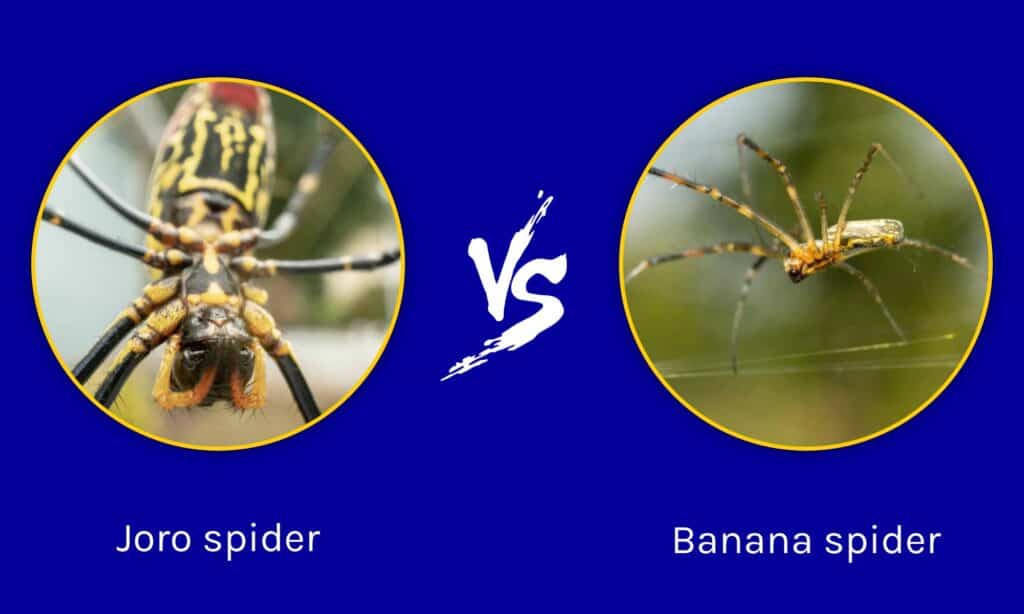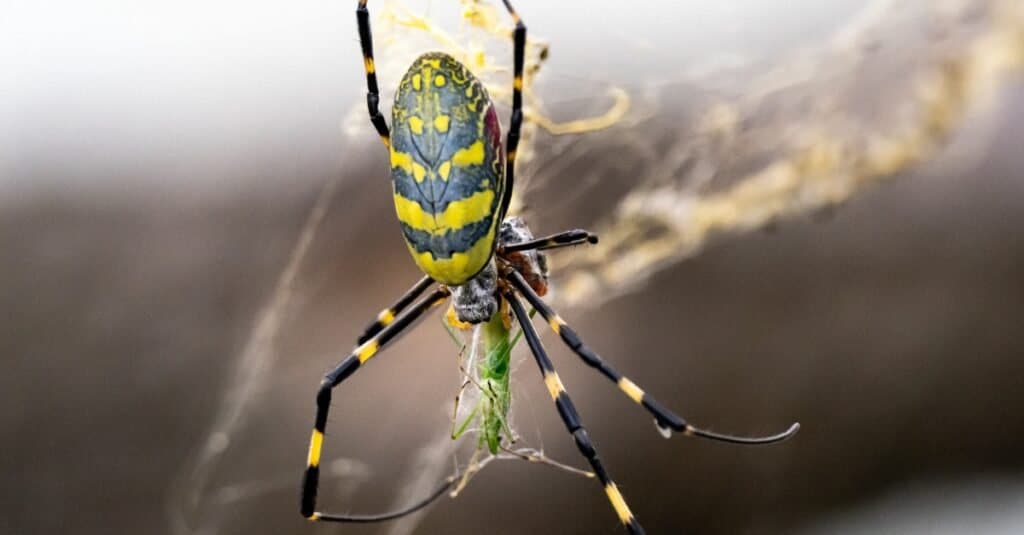Spiders can be interesting, beautiful, and frightening creatures depending on the person you ask. Sadly, misinformation about spiders and their potential danger has cast some of these arachnids in a bad light. Two spiders that are sometimes mistakenly believed to be related and also maligned are the Joro spider and the banana spider. Today, we’re going to explore each creature and define the differences between a Joro spider vs banana spider.
Comparing a Joro Spider and a Banana Spider

| Joro Spider | Banana Spider | |
|---|---|---|
| Size | Weight: 0.2oz-0.5oz Length 0.7in-1in body – Total length of 3in-6in with legspan | Weight: 0.2oz Length 0.5in-2in body – Up to 5 inches with legspan |
| Genus/Species | Trichonephila clavata | Nephila |
| Color | – Integrates blue, yellow, red, brown, and black – Males may have a brown body – Females may be yellow, blue, and red, in alternating patterns, with blue and yellow patterned legs | – Integrates red, green, yellow, white – Variety of colors on its body, including red and green-yellow, with legs that are banded with colors such as red and black or black and yellow – White spots on its thorax |
| Location | – Japan, Korea, China, Taiwan – Lives in Georgia and South Carolina as a non-native species but is also spreading up the East Coast. | – Asia, Africa, Oceania, North America – Prefer to live in warm climates |
| Danger to Humans | – Its bite is not dangerous to humans or their pets – Eats a variety of annoyance creatures, including stinkbugs and mosquitoes | – Venomous bite that can affect humans – Will lead to redness and mild pain |
The Key Differences Between a Joro Spider vs Banana Spider

The banana spider uses its web to catch prey.
©iStock.com/NikonShutterman
The greatest differences between a Joro spider and a banana spider include their genus and species, along with their locations throughout the world. The Joro spider’s scientific name is Trichonephila clavata, and it lives in Japan, Taiwan, Korea, China, and parts of the United States. The banana spider is from the Nephila genus and lives in Asia, Africa, Oceania, and North America.
These are the most prominent differences between the creatures, but they are hardly the only differences. The creatures overlap in some areas of color and body size, so we will explore those areas individually and with greater care.
Joro Spider vs Banana Spider: Size
The Joro spider is larger than a banana spider, including its leg span, but the banana spider has a larger body. Joro spiders have a body that reaches a length of 0.7in-1in, and they weigh up to 0.5oz, but the total length of these arachnids can reach up to 5 or 6 inches!
The banana spider weighs 0.2oz and grows between 0.5in and 2in long, but it can grow up to 5 inches with its leg span included.
Joro Spider vs Banana Spider: Species
The name banana spider is applied to many different species. Some of those species, but rarely the Nephila, are confused for the Joro spider by looks alone. To settle the matter, banana spiders are from Nephila genus. They are also known as golden orb weavers due to the color and complexity of the webs they produce.
Joro spiders are Trichonephila clavata, a specific species that are easy to confuse for a dangerous spider due to their bright colors. However, they are golden orb-webbed spiders like the banana spider, so if you see the web without the spider, you may think the other sort is near your home or garden.
Joro Spider vs Banana Spider: Color

Banana spiders can be very yellow, making them easy to confuse with the Joro spider in some cases.
©Yaping/Shutterstock.com
Both Joro spiders and banana spiders are multicolored, and their colors can vary. For example, a female Joro spider can be yellow, blue, and red on the body with alternating colors along with blue and yellow patterns on the legs. Males mostly have brown bodies, though.
Banana spiders vary in color, but they typically integrate red, green, yellow, and white on their bodies. A banana spider will have a significant amount of white on its mostly black thorax, in spots or a pattern, along with green-yellow, yellow, red, or other colors. The legs may be a dark red or black color with bands of yellow and black included. These spiders vary quite a bit in their coloration.
Joro Spider vs Banana Spider: Location
Banana spiders are widespread around the world, preferring warm areas in Africa, Asia, Oceania, and North America. The case of the Joro spider is more interesting. Its original range included Japan, Korea, China, and Taiwan, but it moved to the United States as a non-native species. Currently, they have been spotted in Georgia and South Carolina, but they’re moving across the south and farther north, too.
These spiders use their silk to help them create “balloons” so that they can float long distances. People living on the East Coast of the United States need to be on the lookout because these spiders may be floating into a town near them!
Joro Spider vs Banana Spider: Danger to Humans

Joro spiders may look deadly, but they’re not harmful to people.
©iStock.com/David Hansche
One of the questions on the minds of people that see these spiders is, can this arachnid hurt me? The banana spider is a venomous spider like most other spiders, and it uses that venom to kill its prey. Moreover, this spider is capable of biting human beings.
Yet, when these spiders bite people, they don’t hurt them too much. A bite from this banana spider will lead to redness around the bite area and some mild pain in most cases. This is not a black widow spider or some other highly dangerous spider.
Joro spiders are not dangerous to humans or their pets. They simply do not have fangs long enough to penetrate the skin of humans or pets. Moreover, these spiders are deadly to other annoying insects like stink bugs and mosquitos, creatures that few humans will miss.
The Joro spider and banana spider may seem similar in terms of the webs they spin; they are different species entirely. Although both spiders can now be found in North America, neither poses a significant threat to humans.
The photo featured at the top of this post is © Kelly vanDellen/Shutterstock.com
Thank you for reading! Have some feedback for us? Contact the AZ Animals editorial team.






